Exosomes - Tools and Implications - Cytoskeleton
In eukaryotic cells the plasma membrane acts as an intercellular communication hub. In addition to the classic direct contact mechanisms of cell communication such as gap junctions, cell surface-protein interactions, and secreted peptides or hormones, cells are also known to communicate via reception of lipid encapsulated cellular biomolecules known as extracellular vesicles (EVs)1–3. As the study of EVs has grown, so too has the delineation between the types of EVs. Apoptotic bodies are 500-2000 nm EVs that have bud off the membrane of apoptotic cells and are typically removed via macrophage phagocytosis. The 50-1000 nm microvesicles are smaller buds off the plasma membrane that deliver biological cargo to neighboring cells. Exosomes are 30-100 nm EVs that contain active biomolecule cargo but are distinguished from microvesicles based on their biogenesis. Exosomes are constitutively produced from inward buddings of the membranes of endosomal compartments that subsequently form intraluminal vesicles (ILVs) and are typically found within multivesicular bodies (MVBs). Exosome-containing MVBs face two fates: 1) fusion with the lysosome for degradation of contents, or 2) fusion with the plasma membrane followed by expulsion of exosomes into extracellular space4. Exosomes are found in almost all physiological fluids and once mobilized, exosomes can facilitate cell-to-cell communication via their diverse cargo that is known to include proteins, lipids, microRNAs (miRNAs), messenger RNAs (mRNAs), and long non-coding RNAs (lncRNAs)5,6. Due to the bioactive content of exosomes, cellular uptake can result in a variety of cellular responses including modulating gene and/ or protein expression. As such, exosomes have become an active area of investigation. |  |
Exosomes are implicated in neuron-to-astrocyte communication Astrocytes of the central nervous system work in concert with neurons by supplying them with neurotransmitter precursors, energy substrates, and maintaining glutamate homeostasis 7,8. To further understand the relationship between neurons and glial cells investigators have begun to investigate how exosomes mediate intercellular communication in cell-to-cell communication within cell types (neuron-neuron), and also across cell types (glial-neuron)9. A recent study by Men et al. found that relative to in vivo astrocytes, cultured astrocytes possess diminished levels of miR-124-3p and a corresponding dearth of precursor pri-miR-12410. Injection of exogenous Cy5-labeled exosomes into mice confirmed astroglia uptake of miR-124-3p, which was reversible by exosome secretion-inhibitor GW4869. Following GW4869 treatment, in vivo astrocytes exhibited reduced levels miR-124-3p, cogently supporting that miR-124-3p levels are a consequence of exosome delivery. Transfection of miR-124-3p inhibited expression of glutamate transporter 1 (GLT1)-inhibiting miR-132 and miR-218 with concomitant increased expression of GLT1 protein. These data demonstrate a previously undescribed mechanism by which exogenous miRNAs from neurons regulate astrocyte function10. Exosomes may play a role in the reparatory process after insult A study by Cheng et al. determined that acute myocardial infarcted (AMI) mice release exosomes enriched in myocardial microRNAs (myo-miRs) that can be detected and isolated from peripheral11. They further demonstrated through flow cytometry that isolation and transfer of fluorophore-labeled exosomes to non-AMI mice displayed enrichment in distant tissues, predominantly in bone marrow mononuclear cells (BM-MNCs). Naïve mice injected with exosomes purified from AMI mice exhibited a significant decrease in expression of the transmembrane chemokine receptor 4 (CXCR4). Interestingly, CXCR4 levels, co-implicated with CXCR1 in the mobilization of progenitor cells (PC) into circulation, could be reduced with injection of myo-miR loaded exosomes. Consequently, mice injected with AMI exosomes exhibited great numbers of colony-forming progenitor cells suggesting that the mobilization of bone marrow PC into circulation is partially controlled by exosome myo-miRs released from the infarcted heart and may aid recovery post-myocardial infarction11.
|
References
|

